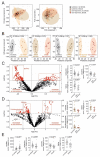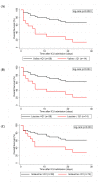Branched-Chain Amino Acids Can Predict Mortality in ICU Sepsis Patients
- PMID: 34578983
- PMCID: PMC8469152
- DOI: 10.3390/nu13093106
Branched-Chain Amino Acids Can Predict Mortality in ICU Sepsis Patients
Abstract
Sepsis biomarkers and potential therapeutic targets are urgently needed. With proton nuclear magnetic resonance (1H NMR) spectroscopy, several metabolites can be assessed simultaneously. Fifty-three adult medical ICU sepsis patients and 25 ICU controls without sepsis were prospectively enrolled. 1H NMR differences between groups and associations with 28-day and ICU mortality were investigated. In multivariate metabolomic analyses, we found separate clustering of ICU controls and sepsis patients, as well as septic shock survivors and non-survivors. Lipoproteins were significantly different between sepsis and control patients. Levels of the branched-chain amino acids (BCAA) valine (median 43.3 [29.0-53.7] vs. 64.3 [47.7-72.3] normalized signal intensity units; p = 0.005), leucine (57.0 [38.4-71.0] vs. 73.0 [54.3-86.3]; p = 0.034) and isoleucine (15.2 [10.9-21.6] vs. 17.9 [16.1-24.4]; p = 0.048) were lower in patients with septic shock compared to those without. Similarly, BCAA were lower in ICU non-survivors compared to survivors, and BCAA were good discriminators for ICU and 28-day mortality. In uni- and multivariable logistic regression analyses, higher BCAA levels were associated with decreased ICU- and 28-day mortality. In conclusion, metabolomics using 1H NMR spectroscopy showed encouraging potential for personalized medicine in sepsis. BCAA was significantly lower in sepsis non-survivors and may be used as early biomarkers for outcome prediction.
Keywords: ICU; NMR spectroscopy; branched-chain amino acids; lipoproteins; metabolomics; sepsis.
Conflict of interest statement
The authors declare no conflict of interest.
Figures






References
-
- Fleischmann C., Scherag A., Adhikari N.K., Hartog C.S., Tsaganos T., Schlattmann P., Angus D.C., Reinhart K., International Forum of Acute Care T. Assessment of Global Incidence and Mortality of Hospital-treated Sepsis. Current Estimates and Limitations. Am. J. Respir. Crit. Care Med. 2016;193:259–272. doi: 10.1164/rccm.201504-0781OC. - DOI - PubMed
-
- Singer M., Deutschman C.S., Seymour C.W., Shankar-Hari M., Annane D., Bauer M., Bellomo R., Bernard G.R., Chiche J.D., Coopersmith C.M., et al. The Third International Consensus Definitions for Sepsis and Septic Shock (Sepsis-3) JAMA. 2016;315:801–810. doi: 10.1001/jama.2016.0287. - DOI - PMC - PubMed
-
- Ryoo S.M., Han K.S., Ahn S., Shin T.G., Hwang S.Y., Chung S.P., Hwang Y.J., Park Y.S., Jo Y.H., Chang H.L., et al. The usefulness of C-reactive protein and procalcitonin to predict prognosis in septic shock patients: A multicenter prospective registry-based observational study. Sci. Rep. 2019;9:6579. doi: 10.1038/s41598-019-42972-7. - DOI - PMC - PubMed
-
- Reisinger A.C., Schuller M., Holzer M., Stadler J.T., Hackl G., Posch F., Marsche G., Sourij H., Ekart R., Eller K., et al. Arylesterase Activity of HDL Associated Paraoxonase as a Potential Prognostic Marker in Patients With Sepsis and Septic Shock-A Prospective Pilot Study. Front. Med. (Lausanne) 2020;7:579677. doi: 10.3389/fmed.2020.579677. - DOI - PMC - PubMed
MeSH terms
Substances
LinkOut - more resources
Full Text Sources
Medical

